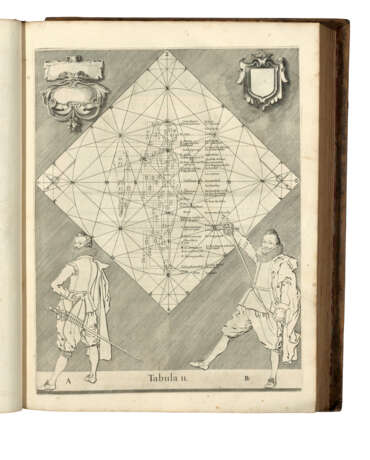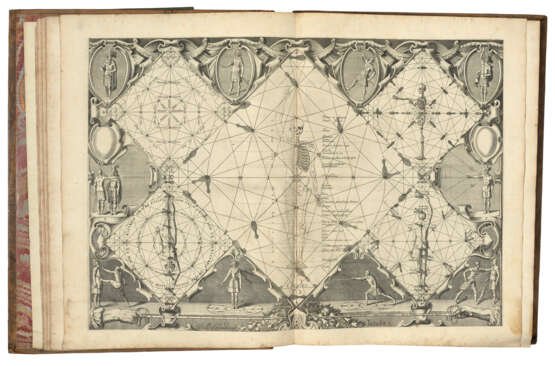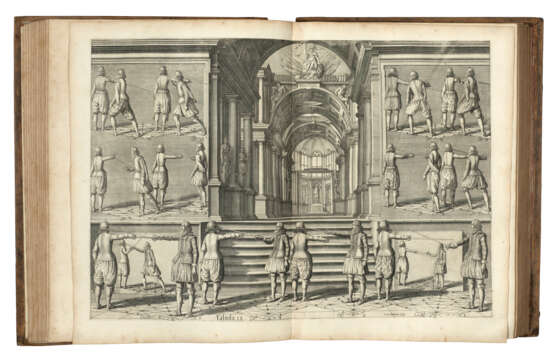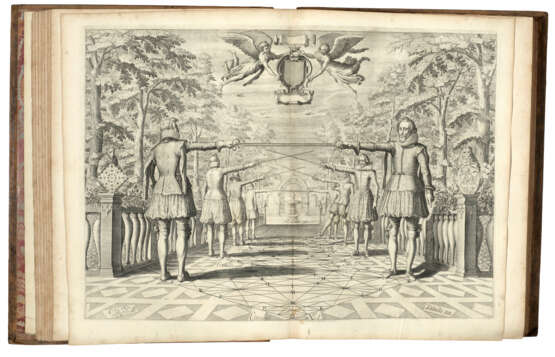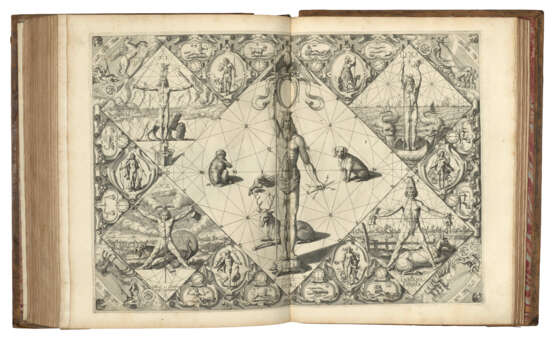ID 1105610
Lot 81 | THIBAULT, Girard (c.1574-1627)
Estimate value
£ 2 500 – 3 500
Academie de l'Espee ... ou se demonstrent per reigles mathematiques sur le fondement d'un cercle mysterieux le theorie et pratique des vrais et jusqu'a present incognus secrets du maniement des armes a pied et a cheval. [Leiden: B. & A. Elzevir], 1628.
The most sumptuous book on fencing ever produced: a triumph of the art of book production with inspired typography blending seamlessly with very fine engraving. The preliminary leaves are ordered inconsistently between copies, and no priority has been established. The Academie de l'Espee is the finest publication of the Elzevir press, and one of the 17th-century's most lavish publications. Gerard Thibault was born at Antwerp around 1574 and followed other members of his family into the wool trade. In about 1603, he was living at Sanlucar de Barrameda, south of Seville, where he learned the mathematical method of fencing taught by the famous Luis Pacheco de Narvaez. Thibault further refined and elaborated on this system and, soon after returning to Flanders in 1611, presented himself and his system to the Dutch fencing masters assembled at Rotterdam for a competition. After further demonstrations to Prince Maurice and Prince Henry, he conceived of the idea for his book. Thibault's system is based on the ‘mystic circle,’ a diagram drawn on the floor within a circle, the radius of which is in accurate proportion to the stature of the fencer and the length of his sword. The circle was marked according to the probabilities of strokes and parries, and one contestant was intended to traverse from one intersection to the next. If this stepping was done correctly, the result was a foregone victory, and if both contestants followed the system, they could fence without fear of injury. The 46 plates are the work of 16 different engravers from Amsterdam, The Hague, Haarlem, Leiden, Delft, Utrecht, and Germany. Two plates are enlarged copies of emblematic engravings in praise of fencing which Michel le Blon had produced for Thibault around 1615. BM/STC French, T-314; Brunet V, 816; Graesse VII, 133; Lipperheide Td 25.
Two parts in one volume, large folio (550 x 430 mm). Engraved portrait of the author, 9 plates of coats-of-arms, 45 plates (only, of 46), all but one double-page, by Crispin de Passe (1), Wilhelm Jacob Delff (3), J. Gilli (6), Crispian Quebon (6) and others, divided into 33 sections in the first part, and 13 sections in the second, each separately paginated and preceded by an engraved plate (part one: lacking engraved title, the portrait remargined and with tears repaired, 6th plate of coat-of-arms with 155mm tear repaired with old paper to verso and with only tiny loss, pl. II with 65mm tear with old paper repair to verso and with only tiny loss, pl. X with large chip repaired with only tiny insignificant loss, pl. XI creased and lower margin soiled and chipped, pl. XVI lightly browned and with short marginal tear, tiny marginal burn hole to one leaf of text, one repaired marginal tear to text leaf just entering text affecting one letter; part two: lacking final plate, text to final plate present, but creased and spotted and with small hole in affecting woodcut headpiece on recto and a couple of words on verso, pl. III with very short marginal tear, pl. VIII bound in upside down, pl. X with 100mm marginal tear just into extreme edge of plate; variable scattered light spotting, browning and staining). 18th-century calf, covers with gilt border composed of double fillet enclosing two foliate rolls, centre of covers stamped with gilt arms, gilt spine, marbled endpapers (scraped, rubbed and worn, with front cover detached). Provenance: Rudge (unidentified family member, gilt arms on covers) – James Bindley (engraved armorial bookplate, Franks 2543: ‘M.A.F. S.A. Stamp Office, London’).
| Address of auction |
CHRISTIE'S 8 King Street, St. James's SW1Y 6QT London United Kingdom | ||||
|---|---|---|---|---|---|
| Preview |
| ||||
| Phone | +44 (0)20 7839 9060 | ||||
| Buyer Premium | see on Website | ||||
| Conditions of purchase | Conditions of purchase |
